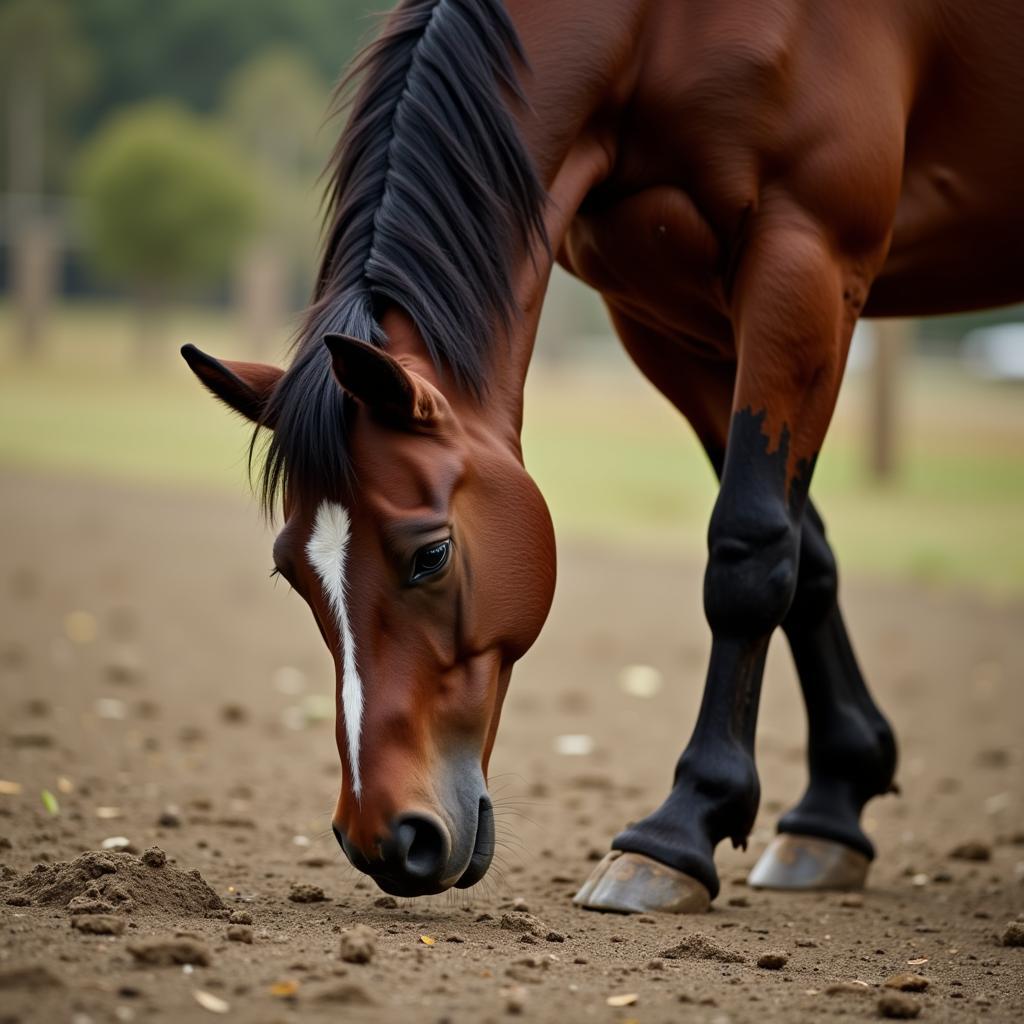Hindgut Ulcer Symptoms In Horses can be subtle and often masked by other conditions, making them a challenge to diagnose. Understanding these signs is crucial for early intervention and effective management of this painful condition. This article will explore the common hindgut ulcer symptoms in horses, the causes, diagnosis, and treatment options available. hind gut ulcers in horses
Understanding Hindgut Ulcers in Horses
Hindgut ulcers, specifically those affecting the cecum and colon, are a growing concern among horse owners. These ulcers, unlike gastric ulcers which occur in the stomach, develop in the lower digestive tract. Several factors can contribute to their development, including stress, changes in diet, and certain medications, particularly non-steroidal anti-inflammatory drugs (NSAIDs). Identifying hindgut ulcer symptoms in horses early is essential for minimizing discomfort and preventing long-term complications.
Common Hindgut Ulcer Symptoms
Hindgut ulcer symptoms in horses can be varied and non-specific. Some common signs include:
- Changes in appetite and weight loss: A horse with hindgut ulcers may exhibit decreased interest in food, resulting in gradual weight loss.
- Mild to moderate colic: Discomfort in the abdomen can manifest as pawing, rolling, or looking at the flanks. The colic associated with hindgut ulcers is often intermittent and less severe than colic caused by other gastrointestinal issues.
- Loose manure or diarrhea: Changes in fecal consistency, including loose manure or diarrhea, can be indicative of hindgut inflammation and ulceration.
- Poor coat condition and dull hair: Nutritional deficiencies resulting from malabsorption due to ulcers can lead to a dull, dry coat.
- Behavioral changes: Horses with hindgut ulcers may show signs of irritability, lethargy, or reduced performance.
 Horse Showing Colic Symptoms – A Potential Sign of Hindgut Ulcers
Horse Showing Colic Symptoms – A Potential Sign of Hindgut Ulcers
Diagnosing Hindgut Ulcers
Diagnosing hindgut ulcers can be challenging due to the location of the ulcers and the non-specific nature of the symptoms. A comprehensive approach is necessary and often involves a combination of the following:
- Physical examination: A thorough physical exam will help assess the horse’s overall health and identify any signs of abdominal discomfort.
- History: A detailed history, including diet, management practices, and any recent medications, can provide valuable clues.
- Fecal examination: Analyzing the horse’s manure can reveal the presence of blood, parasites, or other abnormalities.
- Ultrasound: Ultrasound is a non-invasive imaging technique that can sometimes visualize thickening of the intestinal wall or other changes suggestive of ulceration.
- Biopsy: In some cases, a biopsy of the affected area may be necessary to confirm the diagnosis.
Treatment Options for Hindgut Ulcers
Once hindgut ulcers are diagnosed, treatment typically involves addressing the underlying causes and managing the symptoms. Common treatment strategies include:
- Dietary modifications: Switching to a diet high in forage and low in grain can help reduce inflammation and promote healing.
- Medication: Certain medications, such as sucralfate, can help protect the lining of the gut and promote ulcer healing. Pain relievers may also be prescribed to manage discomfort. best ulcer supplement for horses
- Stress management: Reducing stress through appropriate management practices, such as providing regular turnout and minimizing environmental changes, can help prevent recurrence.
What are the long-term effects of untreated hindgut ulcers in horses?
Untreated hindgut ulcers can lead to chronic pain, weight loss, and poor performance. In severe cases, complications such as intestinal perforation or stricture can occur.
Are certain breeds of horses more prone to developing hindgut ulcers?
While any horse can develop hindgut ulcers, some research suggests that certain breeds, such as Thoroughbreds, may be more predisposed.
Can hindgut ulcers be prevented?
Implementing good management practices, such as providing a balanced diet, minimizing stress, and avoiding overuse of NSAIDs, can significantly reduce the risk of hindgut ulcers.
Conclusion
Hindgut ulcer symptoms in horses can be challenging to recognize, but early diagnosis and appropriate treatment are crucial for a positive outcome. By understanding the common signs, implementing preventative measures, and working closely with a veterinarian, horse owners can help their horses avoid the discomfort and potential complications associated with this condition. cleantrax for horses
FAQ
- What are the most common signs of hindgut ulcers in horses? Changes in appetite, weight loss, mild colic, loose manure, and behavioral changes.
- How are hindgut ulcers diagnosed? Through a combination of physical exam, history, fecal exam, ultrasound, and sometimes biopsy.
- What is the treatment for hindgut ulcers? Dietary modifications, medication, and stress management.
- Can hindgut ulcers be prevented? Yes, by providing a balanced diet, minimizing stress, and judicious use of NSAIDs.
- Are hindgut ulcers the same as gastric ulcers? No, hindgut ulcers affect the lower digestive tract while gastric ulcers occur in the stomach.
- What should I do if I suspect my horse has hindgut ulcers? Contact your veterinarian immediately for a thorough evaluation and diagnosis.
- Can hindgut ulcers be cured? With proper treatment and management, hindgut ulcers can often be successfully healed.
Other potential questions:
- What are the differences between right dorsal colitis and generalized right dorsal colitis?
- What role do NSAIDs play in the development of hindgut ulcers?
For more information on horse health and related topics, visit our website. When you need assistance, please contact us at Phone Number: 0772127271, Email: [email protected] or visit us at QGM2+WX2, Vị Trung, Vị Thuỷ, Hậu Giang, Việt Nam. We have a 24/7 customer service team.